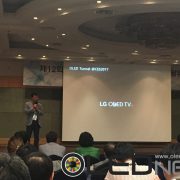[2022 OLED KOREA CONFERENCE] LG Display’s OLED 3.0 Captures Brightness and Lifespan Simultaneously
At the keynote session of UBI Research’s ‘2022 OLED Korea Conference’ held from April 6th to 8th, Sang-Hyun Ahn, Managing Director of LG Display, announced, ‘The Present and Future of Automotive OLED Display: LG Display’s Future Outlook’.

Director Ahn announced, “The future will transform people and vehicles, and vehicles and vehicles to be connected, autonomous, shareable, and electrically driven. In order to respond to these changes, vehicle displays are getting bigger and more diverse in design, and displays are being applied to various locations to provide sights and information”.
Director Ahn continued, “The automotive display industry was led by LCD, but the OLED market is also gradually expanding its area.” He predicted, “The automotive OLED market will be worth $1.2 billion in 2025, It is also possible to grow to $6 billion.”

In addition, Director Ahn said, “LG Display has already introduced an OLED 1.0 structure that satisfies the minimum requirements for automotive display: brightness of 800 nits and lifespan of 10,000 hours. Unlike OLED for smartphones, OLED for automobiles requires brightness of 800 nits or more to grasp accurate information even during the day, and lifespan of 10,000 hours or more is essential because the use cycle is more than 10 years. Although there is a trade-off between brightness and lifetime, we plan to develop OLED 3.0 with a brightness of 1,000 nits or more and a lifetime of 10,000 hours or more by overcoming this through development of materials and structures.”

Lastly, Director Ahn mentioned about future displays such as extra-large and transparent, slidable, and rollable that are applied to vehicles and said, “Many companies want large and many screens, but they want to hide those screens inside the vehicle. Slidable panels, which can be a solution to this, are already technologically stable and can become common around 2025. On the other hand, rollable panels, such as those that come down from a vehicle sunroof, still have a long way to go, but we will continue to develop them.”











